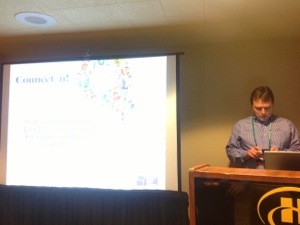 Emerson’s Joel Lemke, Bob Sabin, and Scott Pettigrew presented Instrumentation and End Devices Needed for Improved Boiler Operation at the 2012 Emerson Exchange. Their abstract:
Emerson’s Joel Lemke, Bob Sabin, and Scott Pettigrew presented Instrumentation and End Devices Needed for Improved Boiler Operation at the 2012 Emerson Exchange. Their abstract:
While boilers are critical to plant/mill operation and business results, their performance is often not ideal. Poor combustion results in higher fuel costs and increased emissions. Lack of reliability and response hurts site production throughput and quality. A cause of poor boiler operation is often field devices that are either not present, poorly installed, misapplied, or not functioning as designed. This session will provide guidance on what devices are needed for optimal boiler operation and where they should be placed, as well as preferred technology choices and installation methods.
Bob opened by describing boiler control requirements–safety, reliability and optimized performance in response, fuel cost, and emissions. The focus of the talk is on reliability and optimized performance.
It’s important to begin within a holistic view. While some ask to “come tune my boiler”, it’s important to look across the complete unit. How the boiler is instrumented–measurement, final control, and control system–is important in what can be done in automatic regulatory control. The air system is key to combustion. If this is not in order, there is no chance in having optimized performance. Key devices include damper drive, fan drive, air flow measurement, furnace pressure, furnace temperature, and oxygen analysis. On the water side, key measurements include feed water flow and drum level. On the fuel system, it must be reviewed and current with process safety standards.
Outside of the boilers, measurements are required with the interface to the steam systems and for energy management. The process of evaluation begins with an audit of the current system, a combustion trial to understand current dynamics, making fuel handling modifications, air system upgrades, air flow measurement, and more.
Joel described some key boiler instrumentation. The workshop is too short to address all of the instrumentation required, so Joel highlighted a few. He began with the fuel flow considerations–mass versus volumetric flow, accuracy and turndown requirements, types of fuel, installed performance, installation costs, combustion controls, efficiency monitoring, etc. Best practice is to measure mass flow measurement to better control combustion, provide better mass balance, and reduced process availability. It is especially important in fuel gas or natural gas with the compressibilities involved.
A summary of fuel flow measurement include viscosity measurement for fuel oils, pressure and temperature variations for natural gas, and highly variable BTU content found in fuel and off gases, RFG (refinery fuel gas), COG (coke oven gas), BFG (blast furnace gas) via real-time molecular weight and BTU monitoring.
For steam flow, differential pressure (DP) and vortex meters are the predominant measurement technologies. If you compensate for pressure and temperature, they are very accurate. Each technology has strengths–vortex has a higher turndown (performance over a range) and DP has a slight accuracy advantage at higher flow rates.
For drum levels, maintaining level is critical for safe operation. There are measurement difficulties are that water density fluctuates with pressure and temperature changes as well as water/steam dielectric changes.
DP level measure is used. It’s important to properly installed the measurement, use a condensate pot to know where the level is, and a slope down from condensate pot to drain the water on the high side pressure measurement. Radar measurement installed in a side chamber with taps into the the drum can help compensate for dielectric in high pressure steam. A third way is to use visual indication which is a conductivity-based device. Over time the site glass can be etched and become opaque.
For air flow, considerations include the unique geometries found in ducts. It’s a nightmare flow measurement since airflow patterns are very different based on each unique geometry. The question is how to make the measurement without straight runs. Flow is measured at different sample ports at different combustion rates to get an average of what the airflow is. Annubar flow measurement devices are used for the measurements.
Scott came up to discuss ways to get better airflow measurement. Sometimes there are simple solutions for difficult applications. Standard Annubars use pressure drop created by existing airfoils. Another challenge is very large ducts with low airflow rates. Put multiple devices across a large cross section of the duct to increase the differential pressure for more accurate measurement.
For dampers, they should be easy, but sometimes they are not. They tend to stick over time and not move properly. Damper types include parallel blades and opposing blade actions each with their strengths in operation for flow measurement. Linkages play a crucial role in damper actuators. Placement of these linkages should be as close as they can be to the dampers to minimize maintenance issues and controllability over time.
Valves used in boilers include ball, butterfly, globe, and plug types. Make sure you have the right valve for the duty it is to perform. The trim in the valve provides linear, quick opening, or equal percentage response. Trim selection is based on fuel type.
Joel wrapped up the presentation by highlighting where to go for more information. Check out the Industrial Energy Solutions page on the Emerson Process Management website.
